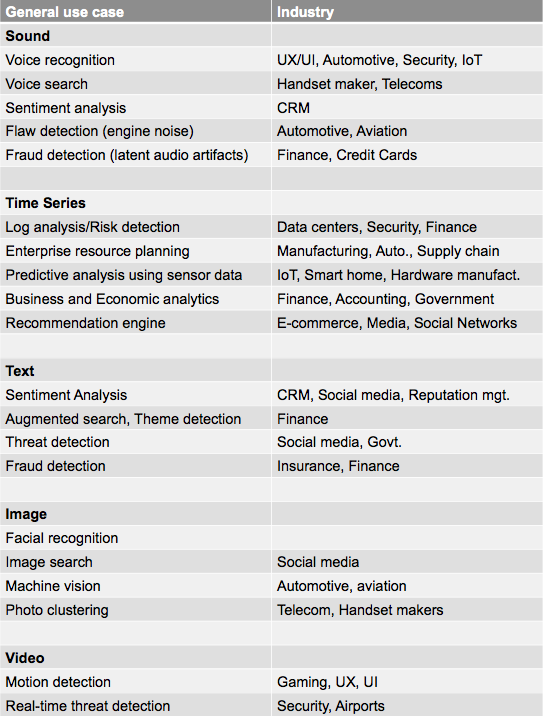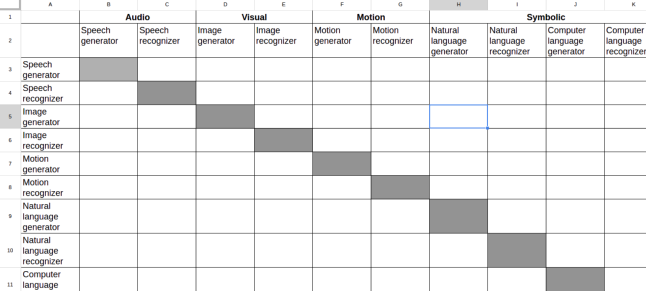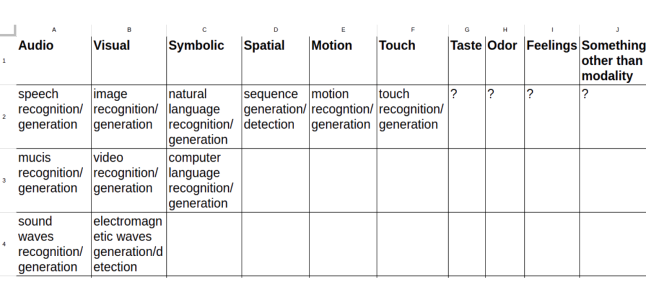Systematic Approach To Applications Of Deep Learning
Hidden potential
The interest in Deep Learning research and applications is as hot as it was never before. A countless number of new research papers can be found at arXiv.org almost every day. Those papers provide us with descriptions of novel ways Artificial Neural Networks can be applied to various fields of our daily life. What is fascinating in Deep Learning is the fact that neural networks seem like universally capable to be applied to various kinds of problems that previously were tackled with a tailored approach. Moreover, each day there is an article or blog post that tells us about even more exotic ways of applying Deep Learning. The problem with those articles, blog post and even books is that they do not provide systematic treatment of neural networks applications. At least, so far I haven’t seen this was done and if you know about such attempts please let me know.
Sate-of-the-art
While searching for materials for this post I’ve found a number of articles that summarize Deep Learning applications. Here comes a number of quotes from those articles with related links.
1. The first post called 8 Inspirational Applications of Deep Learning by Jason Brownlee is from Machine Learning Mastery blog.
Here’s the list:
- Colorization of Black and White Images.
- Adding Sounds To Silent Movies.
- Automatic Machine Translation.
- Object Classification in Photographs.
- Automatic Handwriting Generation.
- Character Text Generation.
- Image Caption Generation.
- Automatic Game Playing.
As it can be seen these applications can be concisely described by the sensory modalities Artificial Intelligence research was initially applied to which are Audio, Visual and Spatial modalities.
2. This one is called Deep Learning Use Cases and is taken from a site dedicated to Deeplearning4j machine learning library for Java.
Source: Deeplearning4j site
As in previous example it is possible to reduce all those applications to only three modality types that are Audio, Visual and Spatial. There is no spatial modality but in the sake of generality I call it so and it refers to sequences.
3. Next one is called Deep Learning Applications in Science and Engineering by John Murphy. This article describes similar applications of Deep Learning as previous ones but also provides more exotic applications, such as Scientific Experiment Design, High Energy Physics and Drug Discovery.
4. In addition I want to mention The Next Wave of Deep Learning Applications post which
is full of most exotic applications that maybe you haven’t heard about them before. To name a few there are Weather Forecasting and Event Detection, Neural Networks for Brain Cancer Detection applications.
5. The last one is a question about Deep Learning applications in Quora that has a number of helpful answers.
What is lacking in all those resources is the systematic approach that not only describes current applications of Deep Learning but which is also capable to predict possible future applications.
Combinations Matrix
I propose to use Combinations Matrix that all current Deep Learning applications can be deduced from and it also has built in merit of hinting for future applications.
This matrix has in its rows and columns various types of sensory modalities organized in such a way that pairs of options of those modalities such as speech – image recognition etc. can be found in it. When a pair is found it may be interpreted in the terms of a current or possible future applications of Deep Learning.
It is hard to see in the screenshot (it is possible to open it in Google Sheet) but if we look at coordinates at row 4 and column B will find there ‘Speech recognizer to Speech generator’ pair from Audio modality which can be interpreted as language too language translation application, such as Google translate. It can be seen that this matrix has following number of possible pairs = 12 * (12 – 1) = 132. In general case pairs = N*(N – 1).
If we want to think about novel application it is possible systematically go over the matrix and look for it or pick a random pair, such as row 5 and column H which is ‘Image generator to Natural language generator’. It may be a story generating application based on generated imagery in turn, which is not so inventive but makes a point.
Notice that this matrix is composed for the sake of an example and it may be organized in other ways that may produce another combinations for possible applications of Deep Learning. Moreover this matrix may be multi-dimensional to take into account tuples of various parameters.
Morphological Matrix
Additional way to try to predict applications of Deep Learning is to use morphological matrix method developed by Fritz Zwicky, Swiss-national astrophysicist based at the California Institute of Technology. By the way, this method has been successfully used to predict the existence of neutron stars. The good explanation of what is morphological matrix and its applications may be found at Swedish Morphological Society. For our purposes it is sufficient to know that this matrix can be composed in such a way that the first row has various sensory modalities such as audio, visual, touch etc. and the rest of the rows provides possible options for those modalities. The screenshot will help to clarify this.
Now that we have a morphological matrix it is possible to think of Deep Learning applications as a set of options of modalities. For example, if we take speech recognition, image recognition, natural language recognition and generation options form the table we can get an essence of the following novel Deep Learning application such as lip reading described in the Lip Reading Sentences in the Wild paper submitted to arXiv.org in November, 16th, 2016.
Notice that this matrix can be composed in other ways to produce different sets of possible applications for Deep Learning.
Conclusion
As it was shown in this post it is possible and effective to systematically look for Deep Learning applications in particular and Machine Learning in general by means of Combinations and Morphological matrices.
| Reference: | Systematic Approach To Applications Of Deep Learning from our JCG partner Andrei Cheremskoy at the GetToCode.com blog. |







